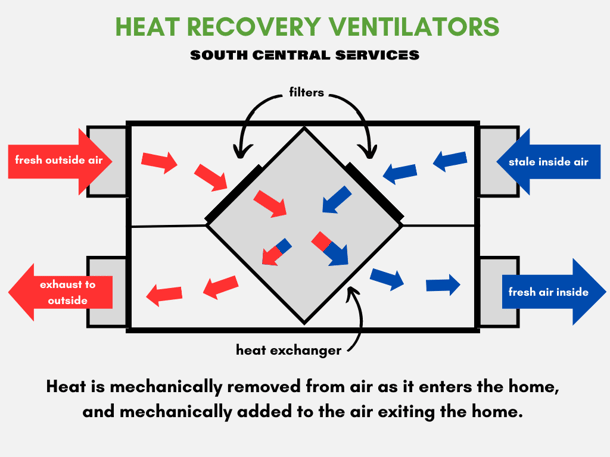Money-Saving Potential of HRV for Homeowners
The All-Inclusive Overview to the Uses of Heat Recovery Ventilation in Modern Structures
Heat Recovery Ventilation (HRV) systems stand for a considerable development in constructing innovation (HRV Heat Recovery Ventilation). They provide an approach for trading stale interior air with fresh exterior air while decreasing energy loss. This strategy not only boosts indoor air top quality however likewise adds to energy performance in both domestic and business buildings. Comprehending the various applications and benefits of HRV can expose its crucial function in modern-day design and sustainability initiatives. The effects of this technology deserve discovering even more
Understanding Heat Recovery Ventilation Solutions

Many modern-day buildings focus on power efficiency, comprehending warm recovery ventilation (HRV) systems is essential for optimizing indoor air quality and minimizing power intake. HRV systems function by moving warmth from stagnant interior air to inbound fresh air, properly maintaining comfy interior temperature levels while decreasing power loss. These systems include a warmth exchanger, followers, and ductwork that promote the circulation of air. During winter, HRV units capture and reuse warmth from the outward bound air, while in summer season, they can aid cool down inbound air. By continually trading air, HRV systems likewise decrease humidity and the focus of interior contaminants. Appropriate installation and maintenance of HRV systems are necessary for their effectiveness and efficiency in enhancing total building efficiency and comfort.
Advantages of Heat Recovery Ventilation
Heat recovery ventilation systems offer various benefits that enhance both energy efficiency and interior air high quality in modern structures. By catching and reusing power from exhaust air, these systems significantly reduce cooling and heating costs, bring about lower power usage. They keep a stable circulation of fresh outside air, decreasing the danger of interior air pollutants and irritants. This constant exchange helps control humidity degrees, preventing mold and mildew growth and making sure a healthier living setting. Furthermore, HRV systems add to sustainability goals by lowering total carbon footprints. Their capacity to optimize ventilation without giving up thermal comfort makes them a beneficial enhancement to modern building design, promoting both financial and environmental advantages.
Applications of HRV in Residential Buildings
As homeowners progressively focus on power efficiency and interior air top quality, the applications of warmth recuperation air flow (HRV) systems in household structures have ended up being a lot more widespread. HRV systems are especially beneficial in firmly sealed homes, where preserving fresh air flow is important for avoiding moisture build-up and interior contaminants. They successfully move heat from outgoing stagnant air to inbound fresh air, minimizing power costs connected with heating and air conditioning. Furthermore, HRVs can improve convenience levels by regulating humidity and temperature. They are likewise versatile for various residential designs, including single-family homes and multi-unit structures. Generally, incorporating HRV systems sustains lasting living techniques while ensuring a healthier interior setting for owners.
HRV in Business and Commercial Setups
In commercial and commercial setups, the execution of warm healing ventilation (HRV) systems has actually ended up being progressively important for maximizing energy effectiveness and maintaining air high quality. These systems effectively transfer warmth from exhaust air to incoming fresh air, lowering the requirement link for extra heating or air conditioning. This not only lowers power prices yet likewise adds to sustainability campaigns. Industries such as production, warehousing, and office complex benefit significantly from HRV systems, as they aid control temperature and moisture levels, ensuring a comfy and productive atmosphere. Additionally, HRV systems help in eliminating contaminants and excess dampness, enhancing interior air high quality. As guidelines around air quality come to be more stringent, the fostering of HRV technology is most likely to grow, making it a critical element of modern-day industrial and commercial infrastructure.
Future Fads in Heat Recovery Ventilation Innovation

Frequently Asked Inquiries
Exactly How Does Heat Recovery Ventilation Influence Indoor Air Quality?
Heat recovery ventilation greatly enhances interior air quality by constantly trading stagnant indoor air with fresh outdoor air while recuperating power. This process decreases toxins, keeps excellent humidity levels, and guarantees a healthier setting for owners.
Can HRV Systems Be Set Up in Existing Structures?
HRV systems can undoubtedly be installed in existing buildings. Retrofitting may need alterations to ductwork and air flow layouts, yet it significantly boosts power performance and interior air high quality, making it a feasible option for older structures.
What Maintenance Is Needed for HRV Solutions?

Are There Details Climates Where HRV Is More Reliable?
Heat recovery ventilation systems are specifically efficient in environments with significant temperature level differences in between periods. These systems enhance energy performance by recouping warm from exhaust air, making them perfect for both cold and reasonably warm settings.
How Do HRV Solutions Affect Energy Costs?
